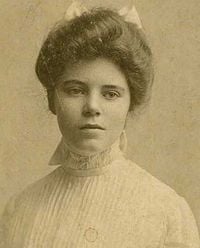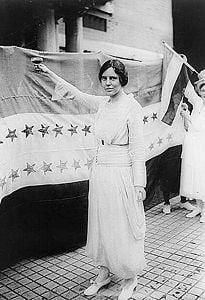Alice Paul
Alice Stokes Paul (January 11, 1885 – July 9, 1977) was an American suffragist leader. Along with Lucy Burns (a close friend) and others, she led a successful campaign for women's suffrage that resulted in granting the right to vote to women in the U.S. federal election in 1920.
Early Life
Alice was born to William and Tacie Paul on January 11, 1885. They were a Quaker family living on the family farm in Mount Laurel, New Jersey. In 1901, she graduated first in her class from the Moorestown Friends School. She later attended Swarthmore College (BA, 1905), the New York School of Philanthropy (social work), and the University of Pennsylvania (MA, sociology). In 1907, Paul moved to England where she attended the University of Birmingham and the London School of Economics (LSE). Returning to the United States in 1910, she attended the University of Pennsylvania, completing a PhD in political science in 1912. Her dissertation topic was: The Legal Position of Women in Pennsylvania. In 1927, she received an LLM followed by a Doctor of Civil Law degree in 1928, both from American University's Washington College of Law.
Career
While she was in England in 1908, Paul heard Christabel Pankhurst speak at the University of Birmingham. Inspired, Paul joined the Women's Social and Political Union (WSPU), where she met fellow American Lucy Burns. Her activities with the WSPU led to her arrest and imprisonment three times. Along with other suffragists she went on hunger strike and was force-fed.
In 1912, Alice Paul joined the National American Women's Suffrage Association (NAWSA) and was appointed Chairman of their Congressional Committee in Washington, DC.[1] After months of fundraising and raising awareness for the cause, membership numbers went up and, in 1913, Alice Paul and Lucy Burns formed the Congressional Union for Women Suffrage. Their focus was lobbying for a constitutional amendment to secure the right to vote for women. Such an amendment had originally been sought by suffragists Susan B. Anthony and Elizabeth Cady Stanton in 1878. However, by the early 20th century, attempts to secure a federal amendment had ceased. The focus of the suffrage movement had turned to securing the vote on a state-by-state basis.
When their lobbying efforts proved fruitless, Paul and her colleagues formed the National Woman's Party (NWP) in 1916 and began introducing some of the methods used by the suffrage movement in Britain. Tactics included demonstrations, parades, mass meetings, picketing, suffrage watch fires and hunger strikes. These actions were accompanied by press coverage and the publication of the weekly Suffragist.
In the election of 1916, Paul and the NWP campaigned against the continuing refusal of President Woodrow Wilson and other incumbent Democrats to actively support the Suffrage Amendment. In January 1917, the NWP staged the first political protest ever to picket the White House. The picketers, known as "Silent Sentinels," held banners demanding the right to vote. This was an example of a non-violent civil disobedience campaign. In July 1917, picketers were arrested on charges of "obstructing traffic." Many, including Paul, were convicted and incarcerated at the Occoquan Workhouse in Virginia (now the Lorton Correctional Complex) and the District of Columbia Jail.
In protest of the conditions in Occoquan, Paul commenced a hunger strike. This led to her being moved to the prison’s psychiatric ward and force-fed. Other women joined the strike, which combined with the continuing demonstrations and attendant press coverage, kept the pressure on the Wilson administration. In January, 1918, the president announced that women's suffrage was urgently needed as a "war measure."
In 1920 the Nineteenth Amendment to the United States Constitution secured the vote for women.
Paul was the original author of a proposed Equal Rights Amendment to the Constitution in 1923.[1] She opposed linking the ERA to abortion rights, as did most early feminists. It has been widely reported that Paul called abortion "the ultimate exploitation of women." However, there appears to be no record of her making this statement. On the other hand, there is documentation that strongly suggests that although she did not want the ERA to be linked with abortion, it was for political, rather than ideological or moral, reasons. An article in The Touchstone (2000) provides the following commentary on the relationship between the ERA and her views on abortion:
Alice Paul did oppose the linkage between the ERA and abortion, but that was because of her political astuteness rather than any disagreement with abortion. Paul felt that by linking the ERA with abortion, the ERA would not pass through Congress. Willis wrote, "She did not address issues of birth control, i.e., abortion, or even women's sexuality, and was concerned that the radical women of the 1960's might alienate support by emphasizing these issues...[S]he said that even if women did want to do many things that she wished they would not do with their freedom, it was not her business to tell them what to do with it, but to see that they had it."[19] This demonstrates that Alice Paul supported equal rights for women, including the right to choose abortion...[2]
Although no documentation of Alice Paul's actual views exist apart from the Suffragist Oral History Project, according to Pat Goltz, Feminists for Life cofounder, who spoke with her in the late seventies, and Evelyn Judge, a life long friend, Alice Paul did indeed oppose abortion, and even referred to it once as "killing unborn women."
In 2004, HBO Films broadcast "Iron Jawed Angels," chronicling the struggle of Alice Paul (portrayed by Hilary Swank) and other suffragists. In 2005, her alma mater, Swarthmore College, named its newest student dormitory in honor of Alice Paul after a donor agreed to select one of the top few student-provided suggestions.
Footnotes
- ↑ 1.0 1.1 Cite error: Invalid
<ref>tag; no text was provided for refs namedLakewood - ↑ Finlay, B., C. Walther, and A. Hinze "What the Founders of Feminism Really Thought About Abortion" The Touchstone, Vol. X, No. 3, Summer 2000.
External links
- The Alice Paul Institute
- Alice Paul at Lakewood Public Library: Women In History
- The Sewall-Belmont House & Museum—Home of the historic National Woman's Party]
ReferencesISBN links support NWE through referral fees
- Lunardini, Christine A From Equal Suffrage to Equal Rights: Alice Paul and the National Woman's Party, 1910-1928, Lincoln, NE: iUniverse, 2000 ISBN 059500055X
- Raum, Elizabeth Alice Paul (American Lives) NY: Heinemann, 2004 ISBN 1403457034
- Butler, Amy ETwo Paths to Equality: Alice Paul and Ethel M Smith, Albany: State University of New York Press, 2002 ISBN 0791453200
Credits
New World Encyclopedia writers and editors rewrote and completed the Wikipedia article in accordance with New World Encyclopedia standards. This article abides by terms of the Creative Commons CC-by-sa 3.0 License (CC-by-sa), which may be used and disseminated with proper attribution. Credit is due under the terms of this license that can reference both the New World Encyclopedia contributors and the selfless volunteer contributors of the Wikimedia Foundation. To cite this article click here for a list of acceptable citing formats.The history of earlier contributions by wikipedians is accessible to researchers here:
The history of this article since it was imported to New World Encyclopedia:
Note: Some restrictions may apply to use of individual images which are separately licensed.

